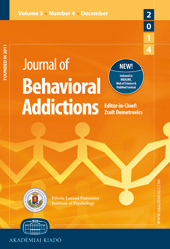Similarities and differences among Internet gaming disorder, gambling disorder and alcohol use disorder: A focus on impulsivity and compulsivity
Similarities and differences among Internet gaming disorder, gambling disorder and alcohol use disorder: A focus on impulsivity and compulsivity
Author(s): Sam-Wook Choi, Hyun Soo Kim, Ga-Young Kim, Yeongju Jeon, Su Mi Park, Jun-Young Lee, Hee Yeon Jung, Bo Kyoung Sohn, Jung-Seok Choi, Dai-Jin KimSubject(s): Psychology, Behaviorism, Methodology and research technology, Substance abuse and addiction, Health and medicine and law, ICT Information and Communications Technologies
Published by: Akadémiai Kiadó
Keywords: behavioral addiction; Internet gaming disorder; gambling disorder; alcohol use disorder; impulsivity; compulsivity;
Summary/Abstract: The aim of the present study was to test the impulsivities and compulsivities of behavioral addictions, including Internet gaming disorder (IGD) and gambling disorder (GD), by directly comparing them with alcohol use disorder (AUD) and a healthy control (HC) group. Methods: We enrolled male patients who were diagnosed with IGD, GD or AUD, with 15 patients per group, as well as 15 HCs. Trait impulsivity was measured using the Barratt Impulsiveness Scale version 11 (BIS-11). The stop-signal test (SST) from the Cambridge Neuropsychological Test Automated Battery (CANTAB) was used to assess the patients’ abilities to inhibit prepotent responses. Compulsivity was measured using the intra–extra dimensional set shift (IED) test from the CANTAB. The Trail Making Test (TMT) was also used in this study. Results: The IGD and AUD groups scored significantly higher on the BIS-11 as a whole than did the HC group (p = 0.001 and p = 0.001, respectively). The IGD and AUD groups also scored significantly higher on the BIS-11 as a whole than did the GD group (p = 0.006 and p = 0.001, respectively). In addition, the GD group made significantly more errors (p = 0.017 and p = 0.022, respectively) and more individuals failed to achieve criterion on the IED test compared with the IGD and HC groups (p = 0.018 and p = 0.017, respectively). Discussion: These findings may aid in the understanding of not only the differences in categorical aspects between individuals with IGD and GD but also in impulsivity–compulsivity dimensional domains. Conclusion: Additional studies are needed to elucidate the neurocognitive characteristics of behavioral addictive disorders in terms of impulsivity and compulsivity.
Journal: Journal of Behavioral Addictions
- Issue Year: 3/2014
- Issue No: 4
- Page Range: 246-253
- Page Count: 8
- Language: English

